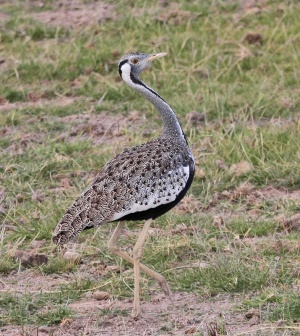- Lissotis hartlaubii
Identification
Male 60 cm (23½ in)
- Thick black post-ocular line
- Thick black line from the eye down to the throat
- Separated by white spot
- Blackish lower back, rump and tail
Similar Species

Photo by Glen Tepke
Amboseli National Park, Kenya, 13 June 2009
Similar to Black-bellied Bustard. Hartlaub should show nice white spikes on upperparts (white margins) combined with reduced dark centers. Tertials are hardly visible (barred in Black-bellied, uniform in Hartlaub)
Distribution
Africa: found from eastern Sudan to Ethiopia, Somalia, northeastern Uganda and northern Tanzania.
Taxonomy
This is a monotypic species[1].
Eupodotis vs. Lissotis
Some authorities (Sibley & Monroe, 1996) lump the genus Lissotis within Eupodotis. however there now seems to be a consensus for using Lissotis..
Habitat
Tall grassland in open areas with scattered acacia trees.
Behaviour
Diet
There is little information; they are known to eat invertebrates and some vegetable matter.
References
- Clements, J. F., T. S. Schulenberg, M. J. Iliff, D. Roberson, T. A. Fredericks, B. L. Sullivan, and C. L. Wood. 2016. The eBird/Clements checklist of birds of the world: v2016, with updates to August 2016. Downloaded from http://www.birds.cornell.edu/clementschecklist/download/
- Handbook of the Birds of the World Alive (retrieved May 2017)
- Kenya Birds
Recommended Citation
- BirdForum Opus contributors. (2024) Hartlaub's Bustard. In: BirdForum, the forum for wild birds and birding. Retrieved 29 April 2024 from https://www.birdforum.net/opus/Hartlaub%27s_Bustard
External Links
GSearch checked for 2020 platform.1




